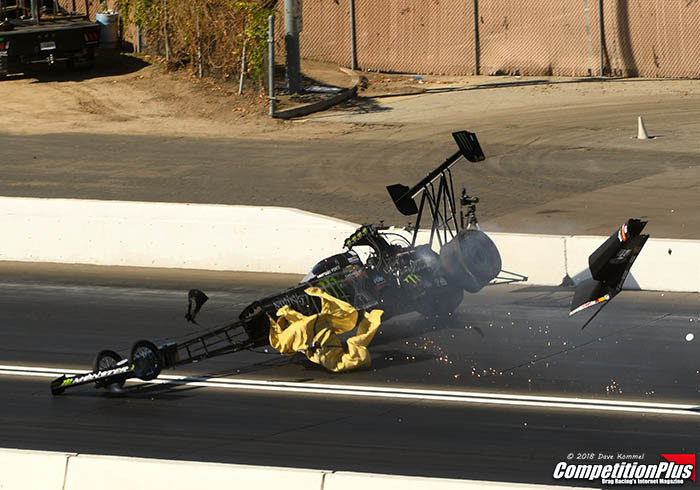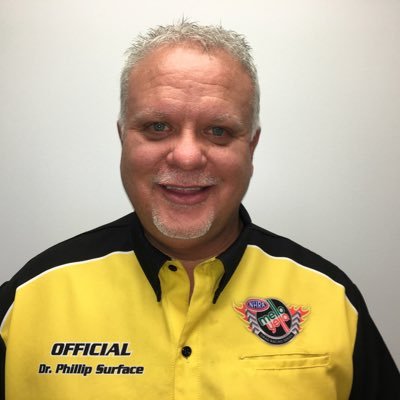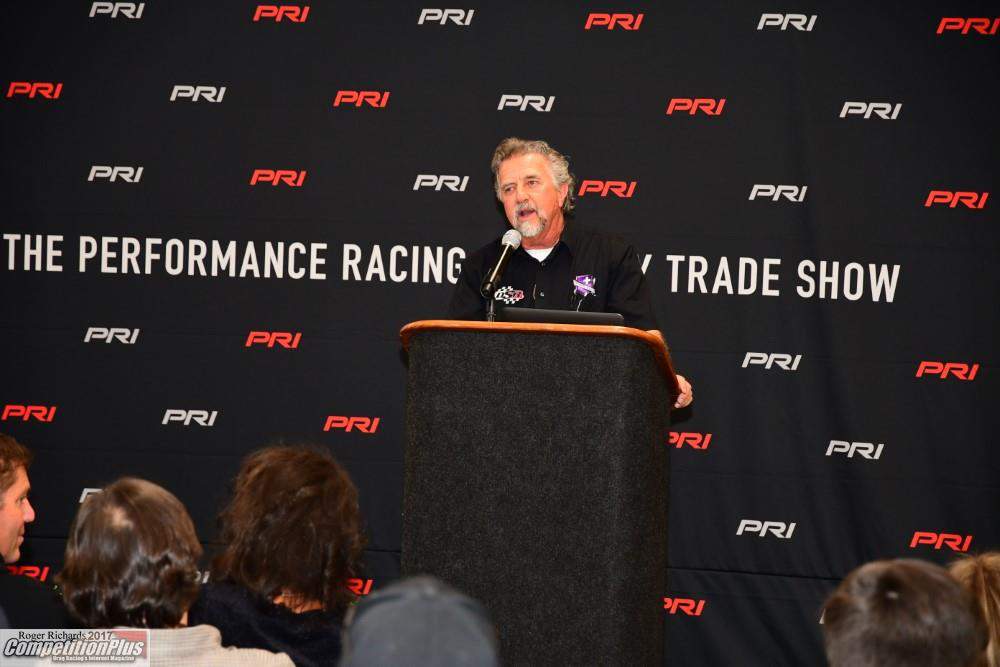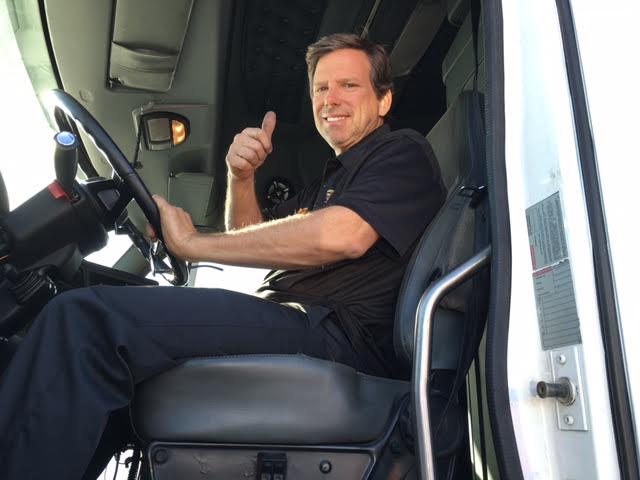NHRA CONTENDS CONCUSSION PROTOCOL IS IN PLACE
RELATED COMMENTARY: NHRA NEEDS A CONCUSSION PROTOCOL
RELATED STORY: DSR MAKES MAJOR COMMITMENT TO CONCUSSION RESEARCH

While its policy might not be common knowledge among its competitors, NHRA contends it has an effective concussion protocol in place. This, according to NHRA's Medical Consultant Dr. Phillip Surface.
“I think the NHRA is proactive and becoming more so every day,” Surface said. “I think in the past few seasons they have really taken ahold of the closed head injury concussion issue and updated policies and procedures and made certain that all the training is standardized and up to date and everything.
"This has been going on for several seasons, but especially in the past three to four seasons there’s been a renewed interest, an increased interest in it.”
The NHRA's policy for concussion protocol has been questioned as of late, but Surface said, each incident where this kind of injury occurs serves as a learning experience, and no two situations are the same.
For as much as Surface said the NHRA's Medical personnel are aggressive in their protection of the drivers, there are times when incidents slip through the cracks which don't initially provide the telltale symptoms.
Case in point, as recently as during the fall of 2016 race in Las Vegas, Alexis DeJoria made contact with the wall and didn't immediately show signs of a concussion. She voluntarily removed herself from eliminations (after making another run) and the season-finale in Pomona, Ca. DeJoria said later in a statement that Texas Sport and Family Medicine diagnosed her with a concussion.
Surface said NHRA's Medical team used the situation to improve further protocol.
“I think you try to learn from every situation,” Surface admitted. “I think in that scenario, we’ve tried to incorporate some further analysis in the accidents by trying to increase the amount of data that we get from chassis recordings and things like that. We try to incorporate that into the medical evaluation of people and drivers.
"We learned that, and we’ve also learned I think from the Safety Safari medical standpoint, we’ve learned to go back and do more frequent rechecks of drivers after accidents and after incidents occur so that when someone does have an accident and we do the screening for head injury or concussion, and they pass it, we don’t drop it at that point.
“We go back and recheck them in 30 minutes to an hour or so, and then even the next day we go back and recheck with them. And I think that that’s something that we’ve adopted new to try to improve our surveillance.”
The challenge, Surface adds, is educating the public to understand concussions are not a one-size-fits-all diagnosis. In other words, the same head injuries a professional football player might experience aren't necessarily what a driver could face with a single instance of accident, severe tireshake or in impacting a retaining wall.

“I think that there are some similarities between race car drivers and drag racing people in particular, but there’s a lot of differences,” Surface explained. “The similarities are that there’s risk clearly of head injury including concussion, there’s risk of sub-clinical injuries, in other words, things that don’t rise to the level of concussion but cause a person to have a headache or something along those lines.
"And that’s similar to say the NFL, but what’s different about it is that an NFL player basically is subjected to a, depending on the position that they play of course, but a lot of positions on the NFL field, the player is subjected to high G loads every single play, every single down over the course of several hours, and then a couple days off, and then back on the practice field, often times redoing it again.
“So an NFL player is typically subjected to a lot more chronic G loading of their cervical spine and head as opposed to an NHRA professional class driver that has an adverse G load every now and then. I mean they’re all always loading with G’s in a straight line and decelerating, but that’s not what we’re talking about. We’re talking about impact loading, abnormal G loading and that doesn’t happen that often. So that’s where the similarities end. The NFL player is subjected to a lot more G loading in unusual angles and unusual obliquities and stuff multiple times over many, many years. So there’s quite a bit of difference in the two, but there are some similarities.”
“There's an infinite number of ways that a person can get injured whether driving a race car or in everyday life,” Surface continued. “There is a vast array of possibilities that can occur, but I wouldn’t say that the NFL injury risk profile is narrowly defined and ours is as vast as the ocean. I think that there’s fairly significant injuries that can occur, it’s not unlimited. We have safety things in place that help control the types of injuries and the type of head injuries that occur.”
Funny Car racer Del Worsham knows first-hand about the NHRA's concussion protocol. He admits to having had his "bell rung a few times" but believes there was no reason he had to stop driving for a period of time as some would suggest.
Worsham admitted he'd lost consciousness as a result of an accident.
"I don’t think I ever had a closed head injury, and I don’t know if it was even a concussion because I went back and got checked for it and when I went to the hospital, they didn’t even deem it a concussion," Worsham said. "I did have a situation where I was knocked out, and I don’t know if you were knocked out that you have a concussion because we’ve all banged our heads and hit ourselves, and got to a position where we use the term see stars.
"But I did crash one time where I was knocked out. I went to the hospital, I went through their whole protocol, I came back to the track, the NHRA put me through their concussion protocol, and they asked me, basically they told me, ‘Hey, we want you to make a half track pass, we want you to stop eighth-mile, we want to make sure you know where you are on the track. You’ve had a few wrecks and let’s make sure everything is okay."
Worsham said he complied and was allowed to race the next day.
"I don’t know much about concussions personally or being knocked out, or the difference of them. I was knocked out very bad in a wreck in 2000 at the Norwalk, Ohio, Night Under Fire," Worsham explained. "Knocked out to the point where 20 minutes later I figured out where I was. I went and had a CT scan, and I had no concussion. So I don’t know the difference between being knocked out and a concussion. I leave that to the doctors and hopefully the protocols that are in place."
The NHRA's medical staff has been put to the test in the first half of the season. Thus far Funny Car driver John Force was taken to the hospital twice in explosive incidents where he admitted he was either knocked out or dazed by the concussion of the blast. Daughter Brittany Force, who experienced a crash at the beginning of the season, was hospitalized overnight and exhibited symptoms of a concussion per her statements to the media.
In Topeka, Top Fuel driver Audrey Worm suffered a concussion during the third qualifying session and had her weekend end early.
“Our clutch line broke and it sent it into immediate tire shake and it rattled me around a little bit,” Worm said. “That was the first time I ever had anything like that happen. When I got back to the pits and I told my dad that I didn’t feel good. I had a very intense headache and I was nauseous in my stomach and I told my father to go get an NHRA doctor because something didn’t feel right. They did the whole test and asked me questions and I had a slight concussion and I couldn’t rest.”

John Medlen, crewchief for Don Schumacher Racing driver Jack Beckman, believes the NHRA should make their efforts on concussion protocol more public, or at least communicated better to the teams.
Closed head injuries in drag racing hit close to home for Medlen, who lost his son in 2007, the result of a head injury sustained in an accident while testing in Gainesville, Fla.
"Well they very well may have a concussion protocol, but if they do, I don’t know that any of the crew chiefs are aware of it. I certainly am not aware of it," Medlen said.
"In recent events, you’d have to wonder the severity of some of the people that were unconscious for a period of time that were allowed to get right back in the seat. Me personally, I would seriously consider that that protocol may not be adequate.
"Anytime you’re unconscious for a period of time, longer than even a minute, but let’s say in this case two to three minutes, there had to be some sort of a brain trauma that needs further investigation to some lengthy status before somebody can automatically say that this person is fine. There’s many brain injuries that don’t show up for a period of time. So that all needs to be clearly evaluated. I’m sure their efforts are in the right direction, but I don’t think that that’s really evident that they have that protocol. I know they do, but the information that gets to us working people out here, we haven’t seen it yet or heard of it yet."
Medlen would know, during his years of drag boat racing, he experienced more than one concussion as a competitor. He believes the nature of the injury can handicap a driver who races in a sport where every faculty is needed, despite the experience they may possess.
Medlen understands there's much on the line in drag racing where one race can cost a driver a championship.
"A lot of it is just a matter of where you put your priorities," Medlen explained. "We quite often have a knee-jerk reaction to an accident at an intersection, then you later put up a stop sign. Well, I think in a lot of these cases, we need to learn to put the stop sign up before there’s a catastrophic event. So who’s to say that an under-evaluated brain injury, an unconscious event of the brain that that person can say without question that they’re eligible to drive that race car that accelerates at 5 G’s and that brain is in that environment.
"If there’s bleeding in the regions of the brain it’s only going to accelerate all of that. So could we ever get to a point where you under evaluate the severity of a concussion and put them back in the car and the driver pass out? Don’t know. I would hate to ever get to that place where you found that out. So could you be over corrective and over careful? I think that would be the better error than being under careful."
Dr. Surface believes as better diagnostic technology becomes available NHRA will be able to better get out ahead on the diagnoses.
“Going forward, maybe, I don’t think we’re there yet, and I don’t think this is a function of the NHRA being behind the eight ball, or late to the show or whatever, but I just don’t think the technology is there on the medical side for us to be able to have a very specific, accurate way of measuring," Surface explained. "In other words, if we take an accelerometer, let’s say we had an accelerometer on the chassis and it gave us a certain reading. Well, that’s, and you’re looking for a trigger that says, ‘Okay, you underwent so many G’s, you’re out, no matter what you say.’ There are some problems with that because not all G loads are the same on every driver and every chassis. Every chassis’ a little bit different. But more importantly on the medical side, at this point, there are no absolutes with regard to that.
“So there are suggestions out there, there are other sanctioning bodies have certain numbers that they go by, but none of those from a medical standpoint have been validated, have been proven to be totally accurate yet. In other words, they don’t necessarily correlate with what you see clinically. So that’s a medical thing, that’s not an NHRA thing, that’s just the medicine is not there yet. There’s a lot of issues with a concussion that we don’t understand, you know.
Sources close to the situation have indicated the NHRA is in the development stages of a policy which could allow for a substitute driver in certain situations to race for a protocolled driver. The thought process is this will allow drivers to be more forthcoming with injuries.
Dr. Surface believes the time is right for articles such as this one, to ask questions and educate the racing community.
“I think that you’re going to see in the future more education of everyone involved in the sport,” Surface explained. “I think that this discussion right now and the ones that have been in the media recently, I think that those are good, the discussion is good. It’s good to talk about it and bring it to the forefront. It’s good for us to discuss it and I think the NHRA over the past several seasons has made a very good effort.
"Everything can always be improved and I think the NHRA can improve this, but they’ve made a good effort in the past several seasons of educating the professional driving community, in particular, every season at Pomona with an orientation of the Safety Safari and what the functions are and who the players are and what our capabilities are."

Dr. Surface said as early as 2014; the NHRA and Safety Safari began incorporating these discussions into their annual season-opening orientation.
All too often these important messages are brushed aside by racers and teams wishing to go ahead and get started with the new season.
“A seminar was put on and it was really basically an orientation on the safety side of the NHRA, reviewing the physicians involved and the players involved in the Safety Safari team and what their roles are and so forth," Surface explained. "We’ve been working recently to increase our efforts at closing the loop from a medical standpoint of what we see with the driver after an accident and what we see with the chassis and what the tech department’s observations are.
“I think there’s been a big improvement in the past several years towards education, and I think that you’re going to see that there’s going to be more of that going forward because the whole organization was founded on trying to make drag racing safe, and I think that the organization still has that challenge and that goal to make it safe and I think that you’re going to see more of that and I think that’s good. I think these discussions are good. I think you’re going to see more discussions and more education about that.”
Mark Oswald is considered one of the legendary drivers who raced in an era when reporting an undiagnosed head injury wasn't the macho thing to do. Though Oswald claims he never sustained any significant head injuries during his driving career, he admits an untreated shoulder injury still provides lingering effects long after he hung up the driving suit.
Oswald understands this could be the case with some drivers and head injuries from days gone by.
Invincibility and honesty don't always go hand in hand.
"You have a certain mindset when you drive these cars, and you don't think you can get hurt," Oswald admitted. "There was a time when I drove; if you told me I was going to crash, I still would have made the run anyway. That doesn't sound too smart, but that was just our aggressiveness and the way I felt back then."
Back then, a driver getting their bell rung was just part of the game.
Oswald, Surface and the NHRA fully understand today the game has changed.







































